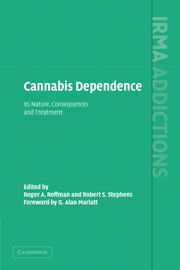Book contents
- Frontmatter
- Contents
- List of Contributors
- Acknowledgments
- Executive Summary
- Foreword
- Part I The Nature of Cannabis Dependence
- 1 Themes in the History of Cannabis Dependence
- 2 The Diagnosis of Cannabis Dependence
- 3 Understanding the Pharmacology and Physiology of Cannabis Dependence
- 4 The Epidemiology of Cannabis Dependence
- 5 The Adverse Health and Psychological Consequences of Cannabis Dependence
- Part II Interventions with Cannabis-Dependent Adults
- Part III Interventions with Cannabis-Dependent Adolescents and Young Adults
- Part IV Policy
- Part V Conclusion
- Index
2 - The Diagnosis of Cannabis Dependence
from Part I - The Nature of Cannabis Dependence
Published online by Cambridge University Press: 29 October 2009
- Frontmatter
- Contents
- List of Contributors
- Acknowledgments
- Executive Summary
- Foreword
- Part I The Nature of Cannabis Dependence
- 1 Themes in the History of Cannabis Dependence
- 2 The Diagnosis of Cannabis Dependence
- 3 Understanding the Pharmacology and Physiology of Cannabis Dependence
- 4 The Epidemiology of Cannabis Dependence
- 5 The Adverse Health and Psychological Consequences of Cannabis Dependence
- Part II Interventions with Cannabis-Dependent Adults
- Part III Interventions with Cannabis-Dependent Adolescents and Young Adults
- Part IV Policy
- Part V Conclusion
- Index
Summary
Introduction
Classification and diagnosis of psychiatric disorders are critical steps in the development of effective methods for their treatment and prevention. This chapter considers the classification and diagnosis of cannabis dependence from several perspectives. First, the nature of the cannabis dependence syndrome is reviewed in terms of its theoretical basis in addiction psychiatry (Edwards et al., 1981). Next, the nature and purpose of psychiatric classification are described in relation to cannabis-related disorders, and this is followed by a review of standard diagnostic procedures recommended by the major classification systems used in the USA and in other parts of the world. The chapter also reviews the scientific evidence for the syndrome, its etiology, course and natural history and closes with a summary of new developments in the measurement of cannabis dependence.
Nature of the Syndrome
Central to current attempts to characterize, classify and diagnose cannabis dependence is the concept of a dependence syndrome that is distinguished from problems or disabilities caused by substance use. A psychiatric syndrome is a cluster of symptoms that co-occur in a way that signals the presence of an underlying disorder. According to an influential position paper developed for the World Health Organization (WHO) (Edwards et al., 1981), the drug dependence syndrome is seen as an interrelated cluster of elements that may be present for a specific substance (e.g., tobacco, alcohol or cannabis), for a class of substances (e.g., opioid drugs) or for a wider range of pharmacologically different substances.
Keywords
- Type
- Chapter
- Information
- Cannabis DependenceIts Nature, Consequences and Treatment, pp. 21 - 36Publisher: Cambridge University PressPrint publication year: 2006
- 2
- Cited by

